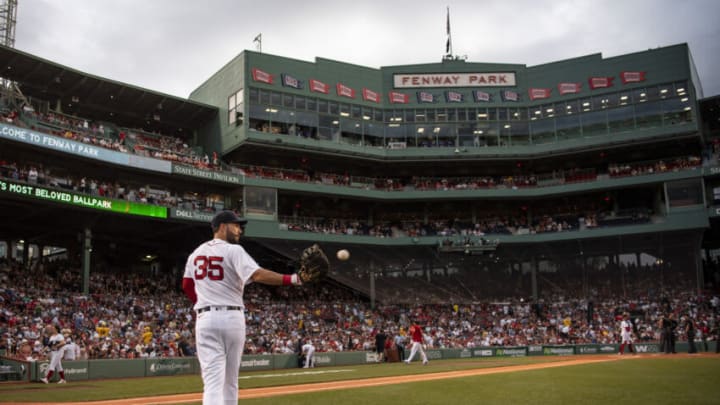Aside from designating Abraham Almonte for assignment in order to claim Caleb Hamilton off waivers from the Minnesota Twins on Wednesday, the Boston Red Sox haven’t done much of anything since the regular season ended last week.
The Sox are expected to be quite active this offseason. They have a significant amount of money coming off the books when several players reach free agency, but they need to use that financial flexibility to overhaul most of their pitching staff, as well as hopefully, give Xander Bogaerts and Rafael Devers the contracts they deserve.
Of course, certain moves – most moves – have to wait until after the World Series. Only then will players officially become free agents and teams will be able to make 40-man roster trades. But while the Sox and other eliminated teams are in limbo while their fellow clubs vie for glory, two wrinkles have already emerged that will impact how they build their roster this winter.
The first is that Tommy Pham’s mutual option is reportedly $12M, not $6M. The Sox are almost guaranteed to decline their side of the deal, but could still bring the veteran outfielder back on a lower-cost contract, perhaps one year with an option for a second.
The second, which carries longer implications, is that Eric Hosmer’s contract now includes a full no-trade clause. When the San Diego Padres dealt him to Boston at the August 2 trade deadline, it triggered a provision that gives him trade protection for the remainder of his deal. So, if the Sox want to trade him, he has to consent.
Would Hosmer decline a trade? It depends. He’s only in Boston because he refused a different trade hours before the eventual Sox deal became official. Originally, the Padres wanted to include him in their blockbuster Juan Soto/Josh Bell trade, but the Washington Nationals were on the list of teams in what was then a partial no-trade clause. His agent, Scott Boras, who also reps Xander Bogaerts and James Paxton, among others, confirmed that Hosmer declined the trade because of the Nats’ current state:
"“Athletes, when they become free agents, they want to have a little more control over where they play, and who they play for. And, certainly, in Eric’s contract, he had a list of teams that he did not want to go to, because he didn’t want to be in a rebuild. He wanted to be in a competitive environment, and we’re very happy that the Padres ownership got involved, and helped trade him to a team that allowed him that opportunity.”"
Whether the Sox are a “competitive environment” remains to be seen, and hinges on what they do this offseason. They certainly weren’t competitive in 2022, finishing last in the American League East for the second time in three years.
This whole situation is now quite complicated. If the Sox want to trade Hosmer, they’ll not only have to find a team to take him but get him to agree to go there. Even with the Padres paying the remainder of his salary, competitive teams might not be interested in a veteran infielder who’s underperformed for most of his current contract. San Diego had been trying to trade him for a while, to no avail; the Nationals were only prepared to take him because of the enormous prospect haul Padres packaged him with, and then Hosmer refused.
It won’t get easier to trade him as he gets older, either. Hosmer is heading into his age-33 season and won’t reach free agency until 2026. While he costs the Sox almost nothing from a financial standpoint, he would occupy a spot on the roster, and unlike the luxury tax threshold, which can be exceeded if the team is willing to pay a penalty, rosters have limits. He’s also accrued enough service time to refuse a demotion to the minor leagues.
Will Triston Casas and Eric Hosmer both be on the 2023 Red Sox roster?
None of this is to say that Hosmer isn’t a capable player. He’s won four Gold Gloves, a Silver Slugger, and a World Series in his dozen big-league seasons. Getting injured 12 games after the trade didn’t really give him a chance to acclimate to his new team, but he’s hit well at Fenway throughout his career.
But with Triston Casas’ impressive late-season debut, the Sox probably don’t need two lefty hitters playing first base, even though Hosmer has been something of a mentor to the Sox rookie for many years. Hosmer could move into the designated hitter role with JD Martinez reaching free agency, but he’s spent little time in the DH role and wouldn’t be able to replicate the formidable slugger’s power. Between 2018-22, Martinez hit 130 home runs for the Sox, averaging 33 round-trippers per 162 games. Hosmer has only hit 196 home runs in his entire 12-year career, never more than 25 in a season, and hasn’t reached 20 home runs since 2019. Martinez’s diminished power this season already hurt the Sox; replacing him with someone who’s hit 29 home runs total over the past three seasons certainly won’t get the job done.
Casas could also DH, or the two could take turns, but the 22-year-old rookie has already proven himself capable of playing solid defense and should get the chance to continue honing that skill. Since Hosmer has played over 1,600 career games at first and virtually nowhere else, it doesn’t leave much room for him.
At the time, it seemed like a smart decision to upgrade from the Bobby Dalbec/Franchy Cordero tandem with a Gold Glover who basically came for free. But in hindsight, the Sox may have backed themselves into a corner.

Predicting the outcome for every Red Sox option for 2023
The Boston Red Sox have several club, player, and mutual options for 2023, including Chris Sale and Xander Bogaerts. Here's a prediction for each one.
